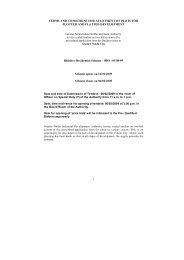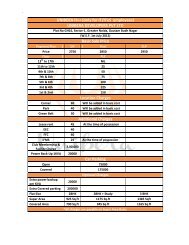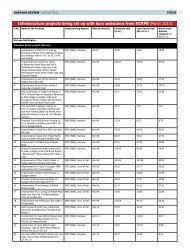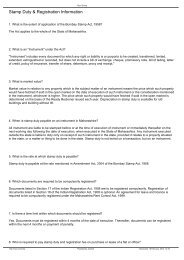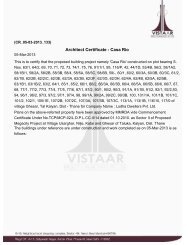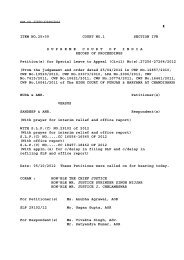eLegalix - Allahabad High Court Judgment Information System ...
eLegalix - Allahabad High Court Judgment Information System ...
eLegalix - Allahabad High Court Judgment Information System ...
You also want an ePaper? Increase the reach of your titles
YUMPU automatically turns print PDFs into web optimized ePapers that Google loves.
JUDGMENT/ORDER IN - WRIT - C No. 37443 of 2011 at <strong>Allahabad</strong> Dated-21.10....http://elegalix.allahabadhighcourt.in/elegalix/WebShow<strong>Judgment</strong>.doPage 106 of 19710/21/2011Each person ought to be entitled to sit back and consider that his appointment and promotion effected a long timeago would not be set aside after the lapse of a number of years." Here as admitted by the State Government inparagraph 55 of the affidavit in reply, all promotions that have been made by the State Government areprovisional and the position has not been crystallised to the prejudice of the petitioners. No rights have, therefore,accrued in favour of others by reason of the delay in filing the petition. The promotions being provisional, theyhave not conferred any rights on those promoted and they are by their very nature liable to be set at naught, if thecorrect legal position, as finally determined, so requires. We were also told by the learned counsel for thepetitioners, and that was not controverted by the learned counsel appearing on behalf of the State Government,that even if the petition were allowed and the reliefs claimed by the petitioners granted to them, that would notresult in the reversion of any Deputy Collector or officiating Deputy Collector to the post of Mamlatdar/Tehsildar;the only effect would be merely to disturb their inter se seniority as officiating Deputy Collectors or as DeputyCollectors. Moreover it may be noticed that the claim for enforcement of the fundamental right of equal opportunityunder Art. 16 is itself a fundamental right guaranteed under. Art. 32 and this <strong>Court</strong> which has been assigned therole of a sentinel on the qui vive for protection of the fundamental rights cannot easily allow itself to be persuadedto refuse relief solely on the jejune ground of laches, delay or the like."The judgment on which much reliance has been placed by the learned counsel for the respondents is theConstitution Bench judgment of the Apex <strong>Court</strong> in Aflatoon & Ors. Vs. Lt. Governor of Delhi & Ors., (1975) 4 SCC285.In the aforesaid case, writ petitions were filed challenging the notification issued under Section 4 of the Act, 1894in the year 1959. The argument which was put forward was that the public purpose as specified in the notificationissued under Section 4, namely, the 'planned development of Delhi" was vague as neither a Master Plan nor aZonal Plan was in existence on the date of the notification and as the purpose specified in the notification wasvague, the appellants were unable to exercise effectively their right under Section 5A of the Act. The Apex <strong>Court</strong>noted in the judgment that after notification under Section 4 of the Act was issued about 6000 objections werefiled under Section 5A by interested persons and several writ petitions were also filed in the year 1966 and 1967,but the petitioners choose to wait till 1972 on the ground that particulars of the public purpose were not specified.In the above, background, the Apex <strong>Court</strong> laid down following in paragraphs 11,12 and 13:-"11.Nor do we think that the petitioners in the writ petitions should be allowed to raise this plea in view of theirconduct in not challenging the validity of the notification even after the publication of the declaration under Section6 in 1966. Of the two writ petitions, one is filed by one of the appellants. There was apparently no reason why thewrit petitioners should have waited till 1972 to come to this <strong>Court</strong> for challenging the validity of the notificationissued in 1959 on the ground that the particulars of the public purpose were not specified. A valid notificationunder Section 4 is a sine qua non for initiation of proceedings for acquisition of property. To have sat on the fenceand allowed the Government to complete the acquisition proceedings on the basis that the notification underSection 4 and the declaration under Section 6 were valid and then to attack the notification on grounds whichwere available to them at the time when the notification was published would be putting a premium on dilatorytactics. The writ petitions are liable to be dismissed on the ground of laches and delay on the part of thepetitioners (see Tilokchand Motichand and Others v. H. B. Munshi and Rabindranath Bose v. Union of India).12. From the counter affidavit filed on behalf of the Government, it is clear that the Government have allotted alarge portion of the land after the acquisition proceedings were finalised to Cooperative housing societies. Toquash the notification at this stage would disturb the rights of third parties who are not before the <strong>Court</strong>.13. As regards the second contention that there was inordinate delay in finalizing the acquisition proceedings andthat the appellants and writ petitioners were deprived of the appreciation in value of the land in which they wereinterested, it may be noted that about 6,000 objections were filed under Section 5A by persons interested in theproperty. Several writ petitions were also filed in 1966 and 1967 challenging the validity of the acquisitionproceedings. The Government had necessarily to wait for the disposal of the objections and petitions beforeproceeding further in the matter. Both the learned Single Judge as well as the Division Bench of the <strong>High</strong> <strong>Court</strong>were of the view that there was no inordinate delay on the part of the Government in completing the acquisitionproceedings. We are not persuaded to come to a different conclusion."The next judgment relied on by the learned counsel for the respondents is the judgment of the Apex <strong>Court</strong> inGeneral Manager, Telecommunication & Anr. Vs. Dr. Madan Mohan Padhan & Ors, 1995 Supp (4) SCC 268.In the aforesaid case, the notification under Section 4(1) of the Act was published in the year 1973 and thereafterdeclaration under Section 6 of the Act was issued on 30/6/1975. Possession of the land was taken on 12/4/1976and the award was given on 02/11/1976. Writ Petition No.1139/1976 was filed challenging the validity of





